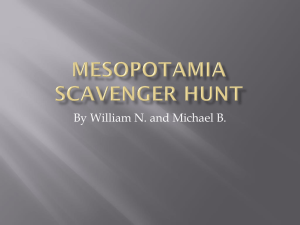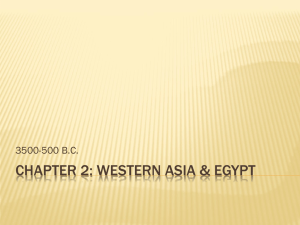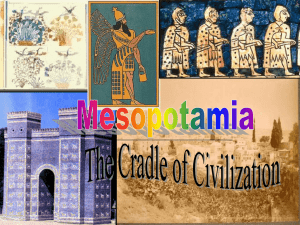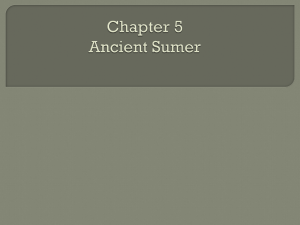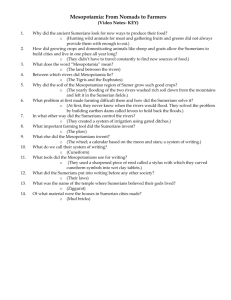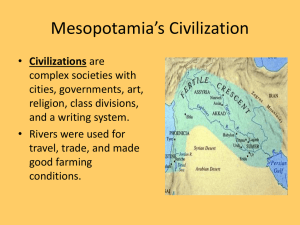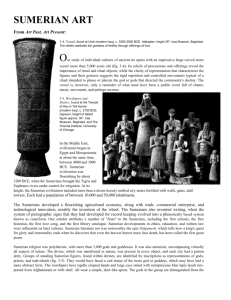real link
advertisement
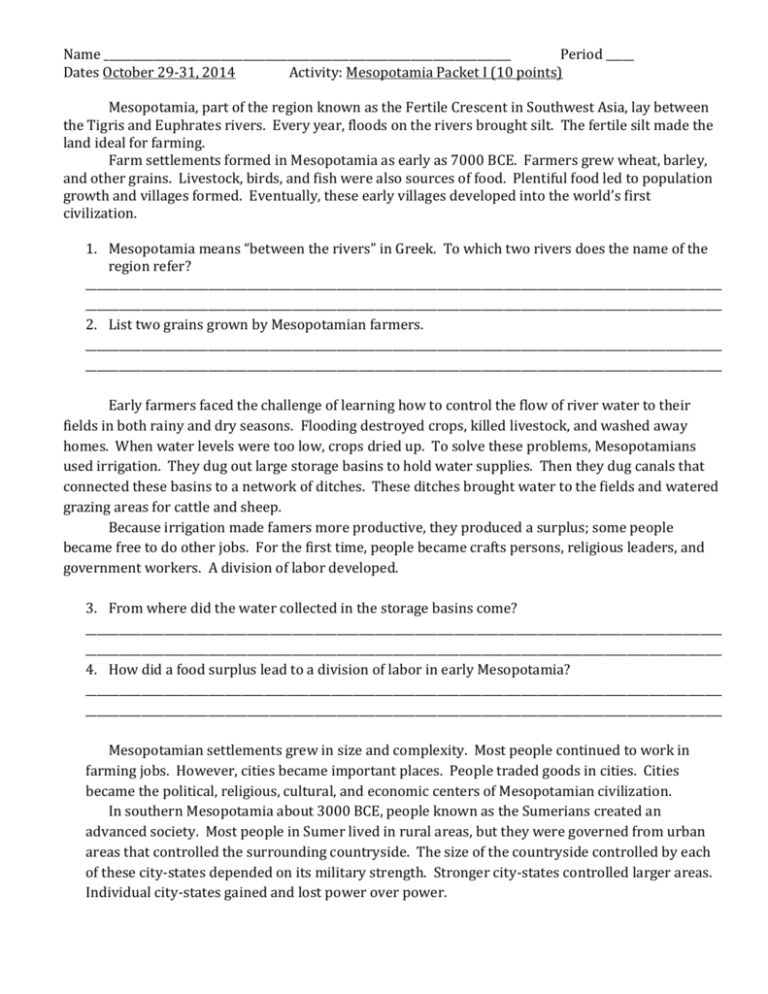
Name _________________________________________________________________________ Period _____ Dates October 29-31, 2014 Activity: Mesopotamia Packet I (10 points) Mesopotamia, part of the region known as the Fertile Crescent in Southwest Asia, lay between the Tigris and Euphrates rivers. Every year, floods on the rivers brought silt. The fertile silt made the land ideal for farming. Farm settlements formed in Mesopotamia as early as 7000 BCE. Farmers grew wheat, barley, and other grains. Livestock, birds, and fish were also sources of food. Plentiful food led to population growth and villages formed. Eventually, these early villages developed into the world’s first civilization. 1. Mesopotamia means “between the rivers” in Greek. To which two rivers does the name of the region refer? __________________________________________________________________________________________________________________ __________________________________________________________________________________________________________________ 2. List two grains grown by Mesopotamian farmers. __________________________________________________________________________________________________________________ __________________________________________________________________________________________________________________ Early farmers faced the challenge of learning how to control the flow of river water to their fields in both rainy and dry seasons. Flooding destroyed crops, killed livestock, and washed away homes. When water levels were too low, crops dried up. To solve these problems, Mesopotamians used irrigation. They dug out large storage basins to hold water supplies. Then they dug canals that connected these basins to a network of ditches. These ditches brought water to the fields and watered grazing areas for cattle and sheep. Because irrigation made famers more productive, they produced a surplus; some people became free to do other jobs. For the first time, people became crafts persons, religious leaders, and government workers. A division of labor developed. 3. From where did the water collected in the storage basins come? __________________________________________________________________________________________________________________ __________________________________________________________________________________________________________________ 4. How did a food surplus lead to a division of labor in early Mesopotamia? __________________________________________________________________________________________________________________ __________________________________________________________________________________________________________________ Mesopotamian settlements grew in size and complexity. Most people continued to work in farming jobs. However, cities became important places. People traded goods in cities. Cities became the political, religious, cultural, and economic centers of Mesopotamian civilization. In southern Mesopotamia about 3000 BCE, people known as the Sumerians created an advanced society. Most people in Sumer lived in rural areas, but they were governed from urban areas that controlled the surrounding countryside. The size of the countryside controlled by each of these city-states depended on its military strength. Stronger city-states controlled larger areas. Individual city-states gained and lost power over power. 5. Why were Mesopotamian cities the centers of the civilization? __________________________________________________________________________________________________________________ __________________________________________________________________________________________________________________ 6. Why do you think governments are usually located in cities? __________________________________________________________________________________________________________________ __________________________________________________________________________________________________________________ Around 2300 BCE, Sargon was the leader of the Akkadians, a people who lived to the north of Sumer. Sargon built a large army and defeated all of the city-states of Sumer as well as all of northern Mesopotamia. With these conquests, Sargon created the world’s first empire. It stretched from the Persian Gulf to the Mediterranean Sea. The Akkadian Empire lasted about 1,500 years. 7. Who established the world’s first empire, and how did he accomplish this feat? __________________________________________________________________________________________________________________ __________________________________________________________________________________________________________________ Religion played an important role in nearly early aspect of Sumerian public and private life. Sumerians practiced polytheism, the worship of many gods. They believed that their gods had enormous powers. The gods could bring a good harvest or a disastrous flood. They could bring illness or good health and wealth. The Sumerians believed that success in every area of life depended on pleasing the gods. Every city-state considered one god to be its special protector. People relied on priests to help them gain the gods’ favor. Priests interpreted the wished of the gods and made offerings to them. A social class system developed in Sumerian city-states. Kings were at the top. Below them were priests and nobles. The middle ranks included skilled craftspeople and merchants. Farmers and laborers made up the larger working class. Slaves were at the bottom of the social order. Although the role of most women was limited to the home and raising children, some upper-class women were educated and even became priestesses. 8. What type of religion did the Sumerians practice? __________________________________________________________________________________________________________________ __________________________________________________________________________________________________________________ 9. In Sumerian religious practice, what did priest do to try to please the gods? __________________________________________________________________________________________________________________ __________________________________________________________________________________________________________________ 10. Which two groups formed the Sumerian upper classes? __________________________________________________________________________________________________________________ __________________________________________________________________________________________________________________ Name _________________________________________________________________________ Period _____ Dates November 3-5, 2014 Activity: Mesopotamia Packet II (10 points) The Sumerians made one of the greatest cultural advances in history. They developed cuneiform, the world’s first system of writing. But Sumerians did not have pencils, pens, or paper. Instead, they used sharp reeds to make wedge-shaped symbols on clay tablets. Sumerians first used cuneiform to keep records for business, government, and temples. As the use of cuneiform grew, simple pictographs evolved into more complex symbols that represented basic parts of words. Writing was taught in schools. Becoming a writer, or scribe, was a way to move up in social class. Scribes began to combine symbols to express complex ideas. In time, scribes wrote works on law, grammar, and mathematics. Sumerians also wrote stories, proverbs, songs, poems to celebrate military victories, and long poems called epics. 1. What was the world’s first system of writing? What are pictographs? ____________________________________________________________________________________________________________________________ ____________________________________________________________________________________________________________________________ The Sumerians were the first to build wheeled vehicles like carts and wagons. They invented the potter’s wheel, a device that spins wet clay as a craftsperson shaped it into bowls. They invented the ox-drawn plow and greatly improved farm production. They built sewers under city streets. They learned to use bronze to make strong tools and weapons. They named thousands of animals, plants, and minerals, and used them to produce healing drugs. The clock and the calendar we use today are based on Sumerian methods of measuring time. 2. Which Sumerian invention greatly improved farm production? How? ____________________________________________________________________________________________________________________________ ____________________________________________________________________________________________________________________________ 3. Which two inventions do you consider to be the most important? Explain your choices. ____________________________________________________________________________________________________________________________ ____________________________________________________________________________________________________________________________ ____________________________________________________________________________________________________________________________ ____________________________________________________________________________________________________________________________ Sumerian remains reveal skill in architecture. A pyramid- shaped ziggurat dominated each city-state. Most people lived in one-story houses with rooms arranged around a small courtyard. Sumerian art is renowned for sculpture and jewelry. Sculptors created statues of gods for the temples, and made small objects of ivory or rare woods. Jewelers worked with imported gold, silver, and fine stones. Earrings and other items fund in the region show that Sumerian jewelers know advanced methods for putting gold pieces together. The Sumerians also developed a special art form called the cylinder seal. The cylinder seal was a small stone cylinder that was engraved with designs that could be rolled over wet clay to decorate containers or to “sign” documents. Music played an important role in Sumerian society. Musicians played stringed instruments, reed pipes, drums, and tambourines both for entertainment and for special occasions. 4. Name four type of musical instruments played by Sumerians. ____________________________________________________________________________________________________________________________ ____________________________________________________________________________________________________________________________ 5. Briefly describe the houses in which most Sumerians lived. ____________________________________________________________________________________________________________________________ ____________________________________________________________________________________________________________________________ By 1800 BCE, a powerful city-state had arisen in Babylon, an old Sumerian city on the Euphrates. Babylon’s greatest monarch, Hammurabi, conquered all of Mesopotamia. He ruled for 42 years. During his reign, Hammurabi oversaw many building and irrigation projects, improved the tax collection system, and brought prosperity through increased trade. He is most famous for Hammurabi’s Code, the earliest known written collection of laws. It contained laws on everything from trade, loans, and theft to injury, marriage, and murder. Some of its ideas are still found in laws today. The code was important not only for how thorough it was, but also because it was written down for all to see. 6. Identify three important achievements of Hammurabi’s leadership. ____________________________________________________________________________________________________________________________ ____________________________________________________________________________________________________________________________ 7. Why do you think it is important for laws to be written down? ____________________________________________________________________________________________________________________________ ____________________________________________________________________________________________________________________________ ____________________________________________________________________________________________________________________________ Several other civilizations developed in and around the Fertile Crescent. Over time, the region passed from one empire to another. The Hittites of Asia Minor captured Babylon in 1595 BCE with strong iron weapons and the skillful use of the chariot on the battlefield. Soon the Hittite king was killed, and the Kassites captured Babylon and ruled for almost 400 years. The Assyrians were the next group to conquer all of Mesopotamia. They ruled from Nineveh, a city in the north. The Assyrians collected taxes, enforced laws, and raised troops through local leaders. The Assyrians also build roads to link distant parts of the empire. In 612 BCE, the Chaldeans, a group from the Syrian Desert, conquered the Assyrians. Nebuchadnezzar, the most famous Chaldean king, rebuilt Babylon into a beautiful city. According to legend, his grand palace featured the famous Hanging Gardens. The Chaldeans revived Sumerian culture and made notable advances in astronomy and mathematics. Phoenicia, along the Mediterranean Sea, created a wealthy trading society. Fleets of fast Phoenician trading ships sailed throughout the Mediterranean and even into the Atlantic Ocean, building trade networks and founding new cities. The Phoenicians’ most lasting achievement, however, was the alphabet. 8. Name four groups that conquered all of Mesopotamia after the Babylonians. ____________________________________________________________________________________________________________________________ ____________________________________________________________________________________________________________________________ 9. Which older Mesopotamian civilization did the Chaldeans admire and study? ____________________________________________________________________________________________________________________________ ____________________________________________________________________________________________________________________________ 10. Hos did the Phoenicians contribute to the development of civilization? ____________________________________________________________________________________________________________________________ ____________________________________________________________________________________________________________________________


